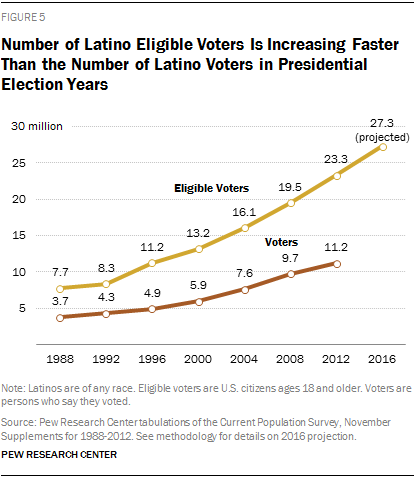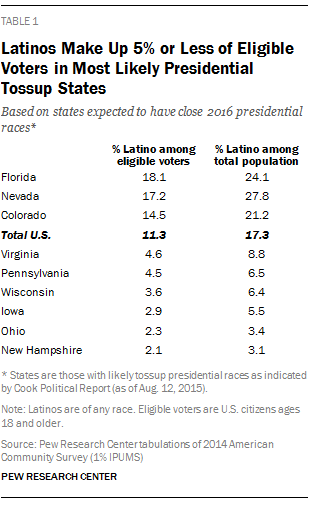Two of yesterday’s news stories may work together to provide a key to the 2016 election. First, from Pew Research: (emphasis by the Wrongologist)
Hispanic millennials will account for nearly half (44%) of the record 27.3million Hispanic eligible voters projected for 2016—a share greater than any other racial or ethnic group of voters…
The median age among the nation’s 35 million US -born Latinos is only 19, and Latino youth will be the main driver of growth among Latino eligible voters for the next two decades.
Latinos made up 17.4% (55 million) of the nation’s population in 2014. They were 11.4% of eligible voters, but only 7.3% of actual US voters. But percentages are not the full story. In 2016, a projected 11.9 million Hispanic millennials will be eligible to vote. Pew gives some perspective on Hispanic voters, who vote at lower levels than other groups:

The chart above shows that in 2012, fewer than half (48%) of Hispanic eligible voters cast a ballot. By comparison, 64.1% of whites and 66.6% of blacks voted.
Can that be turned around? Part of the answer is that Hispanic millennials register to vote at a lower rate than other millennial groups. 50% of Hispanic millennial eligible voters said they were registered to vote in 2012, compared with 61% of white millennials and 64% among black millennials. And only 37.8% of them actually turned out to vote in 2012.
Although they are the largest cohort of Hispanics, they vote less often. The voter turnout rate among Latino millennials also trails that of other millennial groups. 47.5% of white millennials and 55% of black millennials voted in 2012.
Given that Hispanic millennials are the largest bloc of Hispanic voters, and since they are less likely to cast a ballot than older voters, there is an opportunity for either party if they can turn out Hispanic millennials.
The second piece of news bears on the turnout discussion. Yesterday, the US Supreme Court (SCOTUS) took up the case US vs. Texas. This case, brought by 26 Republican-controlled states, addresses whether President Obama exceeded his powers by using an executive order to try to shield millions of illegal immigrants from deportation. Mr. Obama’s immigration program, Deferred Action for Parents of Americans and Lawful Permanent Residents (DAPA), is currently blocked by adverse decisions in several lower courts.
DAPA is very popular among Hispanics, particularly with millennials.
Mr. Obama’s executive order has become one of the most contentious topics in the nation’s political debate. Every Republican candidate for the party’s presidential nomination is against Obama’s plan. The Democratic candidates all say they would keep it in place.
If SCOTUS sides with Texas, eliminating the DAPA program, Hispanics will have a reason to register and to vote in the 2016 election, since, should a Republican become president, there is no possibility that a DAPA-like program would be passed.
If SCOTUS sides with the president, Hispanics should turn out to elect a new Democrat president, who will ensure this executive order remains in place.
It is expected that the Court will take up the case in April, and there will be a decision in June, right in the middle of the 2016 election cycle, so this issue may energize Hispanic millennials and Hispanics generally to turn out in 2016.
We all know that turnout matters. Pew used the Cook Political Report’s analysis of toss-up states that projects nine states as tossups: Colorado, Florida, Iowa, Nevada, New Hampshire, Ohio, Pennsylvania, Virginia and Wisconsin; and looked at the Hispanic voter demographics in those states:

Hispanic turnout will clearly matter in Florida, Nevada and Colorado, and possibly in Virginia and Pennsylvania. They add up to 67 electoral votes and could be a key to the 2016 elections. And despite the immigration controversy, nearly all of these voters are US born. According to Pew, the second-largest group of eligible voters is adult Hispanic immigrants who are in the US legally, and are naturalized citizens. Between 2012 and 2016, 1.2 million became citizens.
The Hispanic vote could make it an interesting fall.

Quick Question Wrongo. If all voters actually had to provide state provided photo identification…Would the Latino voter population go down? Just curious.
The research I quoted totals Latino voters who are legally eligible to vote. Maybe you could take a look at it, its linked in the article. I live in a state that requires photo id at the polls. Do you have ANY statistics about how many people in states like mine get turned away on voting day? Me neither, cause its a small #.